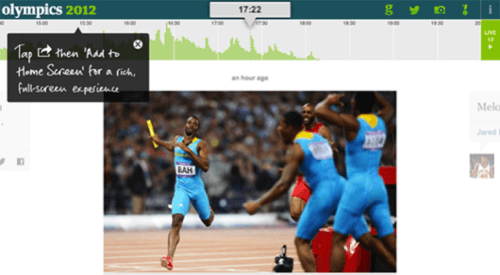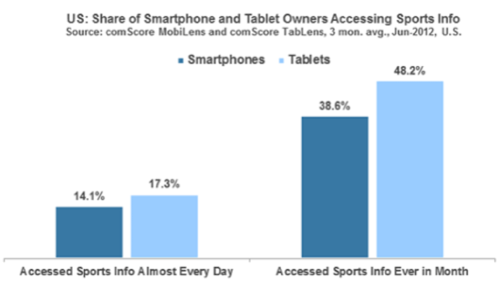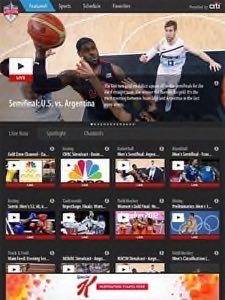
Some people will remember the 2012 Summer Olympics for its thrilling contests and inspiring triumphs. Others will remember it as the beginning of a tense transition from stationary to mobile media. Coverage of the Olympics – and, likely, sports in general – will never be the same.
It’s only fitting that more people would watch this year’s Olympics on a smartphone or tablet – or use those devices to complement what they saw on the bigger screen. Mobile viewing was a huge trend prior to the Olympics, and given the games’ sprawling, global, niche-to-blockbuster gamut, they were guaranteed to attracted a fragmented worldwide audience of mobile viewers.

About 110 million Americans own a smartphone, according to ComScore, a massive increase over 2008, when the last Summer Olympics were held in Beijing and only 20 million Americans had smartphones. Today, tablets are nowhere near as ubiquitous as smartphones, but their numbers are growing dramatically.
ComScore says that 48.2% of U.S. tablet owners used their devices to access sports-related information at least once over the course of a given month. A smaller but growing number (17.3%) did so every day. Even though smartphones are more ubiquitous, they’re not quite as popular as tablets when it comes to watching sports. About 38% of U.S. smartphone owners used their phones as a second screen during or after sporting events.
The Flood of Olympics Apps
These trends were not lost on the International Olympic Committee, individual teams, broadcasters or news publishers. Anticipating the rise of second screens during the Summer Olympics, they flooded the Web with mobile apps.

The official organizing committee of the London Games released two stand-alone apps, both of which were available on iOS and Android. The Official Join In app was designed for real-world visitors to Olympic Park, but there was enough supplemental content – including news, tweets, photos and schedules – to capture the market’s attention.
The second app offered a detailed breakdown of game results. Team USA released its own app for iOS, which featured news, tweets and information about team members.
NBC, whatever heat its broadest strategy may have generated, developed a handful of apps for tablets and smartphones. Rather than craft a unique second-screen experience, the broadcaster released a trio of apps (two in English, one in Spanish) primarily focused on getting viewers to watch feeds and archived video. Like NBC’s other video-heavy mobile and tablet apps, they required a cable or satellite TV account to watch, to dismay of many cord cutters.
News Publishers Vie For Second-Screen Attention
Some of the more immersive and thorough second-screen offerings came from news and magazine publishers.
Naturally, Sports Illustrated released its own Olympics app. It was a rather print-centric, Newsstand-style interface offering daily downloadable mini-magazines, each one rich with photographs and detailed coverage of the day’s events. Sports Illustrated didn’t charge for these downloads but relied on advertising revenue to support the efforts.
Reuters and Agence France-Presse (AFP) both put out unique apps to showcase their Olympics coverage. The Reuters app put the focus on photographs taken by the news agency’s photographers, laid out on a graphical timeline that was clearly designed with the tablet geometry in mind. The AFP’s app was more fleshed out, with video, news headlines, game schedules, results and athlete profiles.

The Guardian Takes the HTML5 Approach
Not everybody went native for their Olympics apps. The Guardian used HTML5 and related technologies to build a browser-based experience that looked and felt like a native tablet app. It lacked the rich library of first-hand video that the BBC or NBC were able to include (because they had the intellectual property rights to do so), but the Guardian did a pretty good job of pulling in tweets, photos, headlines and results, and laying them out on an attractive, minute-by-minute timeline.
As is always the case with browser-based HTML5 apps, this one worked across platforms, and once bookmarked, it was just as easy to access as a native app.
Lessons for 2016
So what can we learn from the first-ever Second Screen Olympics?
It’s hard to measure the impact of these apps without hard data from broadcasters and publishers, but there are clear lessons to be gleaned for both groups. For publishers, the instinct to grab viewer’s attention on their tablets and phones was a wise one, based on the broader trends in second-screen usage alone. Audiences, who are increasingly accustomed to consulting smaller screens while they watch sporting events, were positively captivated by the Olympics this year. 220 million Americans tuned in, and while a relatively small percentage likely checked their second screens, those numbers are growing fast and there’s a huge opportunity for news publishers in future international sporting events. All told, as many as 900 million people watched the games around the world, and social media was a key component of viewer engagement.
On the broadcast side, the second screen seems to have paid off. The BBC said that 12 million people tuned into the games from smartphones and tablets.
NBC now knows precisely how to stir up viewers’ ire with outdated broadcast strategies and poor social-media foresight. And while this year’s Olympics broke records in terms of viewership, it’s hard to imagine audiences tolerating broadcast delays and cable authentication in 2016. By then, fans of the Olympics will be even more entrenched in their habits, and mobile devices will be even more capable and ubiquitous.










